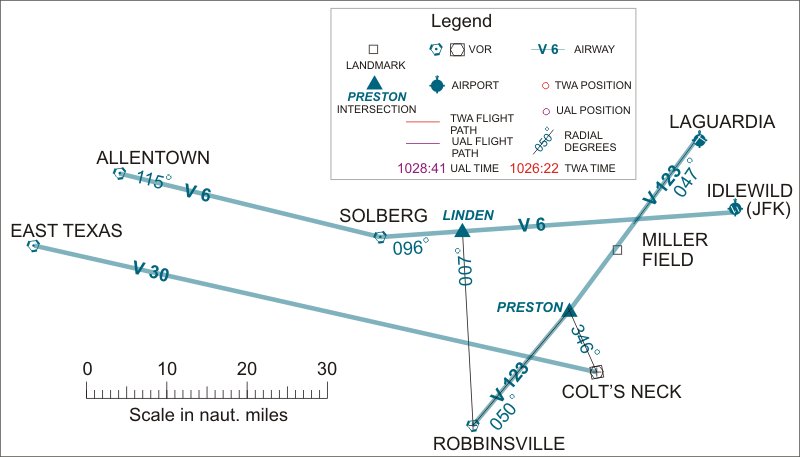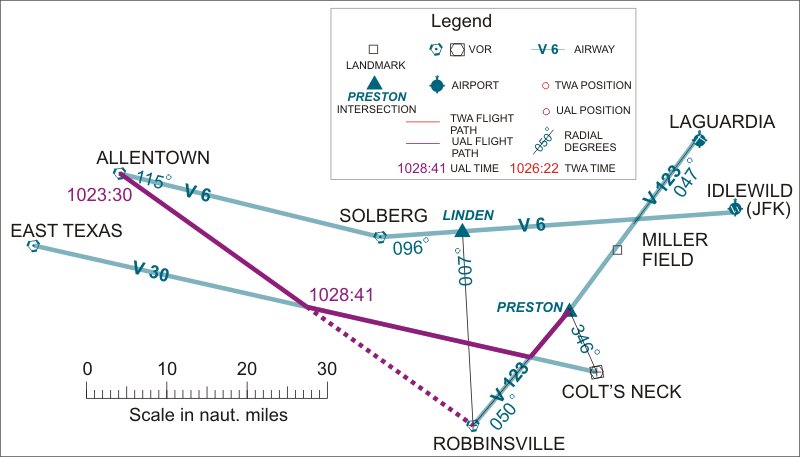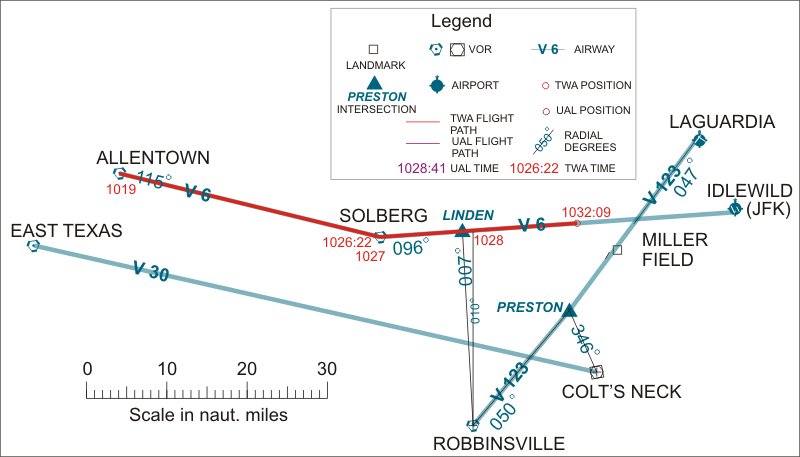

January 15, 2011
 n December 15, 2010, the NY Times did
a retrospective
story on the mid-air collision of two airliners over Staten Island, NY that
occurred on December 16, 1960. The two planes were TWA flight 266 and United
Airlines flight 826. The United plane came to earth in the Park Slope section of
Brooklyn, hence the name of the incident. In 1960, all aviation accidents were
investigated by the Civil Aeronautics Board. Although the CAB's responsibility
for investigating aviation accidents ended with the creation of the NTSB in
1967, the Department of Transportation has made the CAB report on this
accident available on line. This report was originally released on June 18,
1962.
n December 15, 2010, the NY Times did
a retrospective
story on the mid-air collision of two airliners over Staten Island, NY that
occurred on December 16, 1960. The two planes were TWA flight 266 and United
Airlines flight 826. The United plane came to earth in the Park Slope section of
Brooklyn, hence the name of the incident. In 1960, all aviation accidents were
investigated by the Civil Aeronautics Board. Although the CAB's responsibility
for investigating aviation accidents ended with the creation of the NTSB in
1967, the Department of Transportation has made the CAB report on this
accident available on line. This report was originally released on June 18,
1962.
Here is the first paragraph of the report's synopsis:
On December 16, 1960, at 1033 e.s.t., a collision between Trans World Airlines Model 1049A Constellation, N 6907C, and a United Air Lines DC-8, N 8013U, occurred near Miller Army Air Field, Staten Island, New York. Trans World Airlines Flight 266 originated at Dayton, Ohio. The destination was LaGuardia Airport, New York, with one en route stop at Columbus, Ohio. United Air Lines Flight 826 was a non-stop service originating at O'Hare Airport, Chicago, Illinois, with its destination New York International Airport [now called JFK International], New York. Both aircraft were operating under Instrument Flight Rules.
My interest in this disaster was piqued by the fact that both aircraft were flying under Instrument Flight Rules (IFR) and separation between aircraft flying IFR is the responsibility of the government's Air Traffic Control system, a part of the Federal Aviation Administration.
The CAB couldn't afford that kind of sentimentality. It was dealing with a major industry which was wholly dependent on the government and it had to explain the accident in a way that would have the least adverse affect on that government-industry complex.
Here's the CAB's finding as given on p. 26 of the report:
Probable CauseOne thing stands out in the CAB's finding: It was not the fault of the Air Traffic Control system and it wasn't the fault of the airline industry. The government-industry complex comes off clean. Who got blamed? The CAB blamed the guy flying one of the airplanes. Given the fact that the CAB couldn't deny that the accident happened, that's the least damaging thing to the government-industry complex it could say.
The Board determines that the probable cause of this accident was that United Flight 826 proceeded beyond its clearance limit and the confines of the airspace allocated to the flight by Air Traffic Control. A contributing factor was the high rate of speed of the United DC-8 as it approached the Preston intersection, coupled with the change of clearance which reduced the en route distance along Victor 123 by approximately 11 miles.
Is this conclusion correct? It isn't. And that's what this essay is about.
At the time of this accident, the two main commercial airports in the New York area were LaGuardia Airport and New York International Airport. The popular name for the latter was Idlewild Airport. It was renamed John F. Kennedy International Airport on December 24, 1963.
The main instrument feeder routes from points west to these two airports in 1960 are shown in Fig. 1. The mid-air collision took place over Miller Field in Staten Island, NY.

IC graphic
Figure 1: Feeder routes to the two main New York
airports as they existed in 1960.
|
Aircraft are given flight plans at their departure airport and although these could be modified enroute, adherence to them was, and is, absolutely mandatory. Aircraft inbound to the New York area would be handed off to controllers in the NY Air Route Traffic Control Center and then handed off to the respective approach controllers for a specific airport.
For the two aircraft involved in this accident, United Airlines 826 (UA 826) and TWA 266 (TW 266), the approach controllers were Idlewild and LaGuardia, respectively.
By 1960, radar was in routine use in the Air Traffic Control system for tracking aircraft. An important limitation of the radar then in use was that it did not display the aircraft's altitude. Since the controllers were in constant radio communication with the aircraft, this was not a safety limitation. Flight plans always assign an enroute altitude and these assignments are frequently changed, especially during the aircraft's descent to its destination airport. If a controller needs to know an aircraft's altitude, he simply asks the pilot by radio for his altimeter reading.
At the time of the accident, the weather at LaGuardia was:
Ceiling 500 feet overcast, visibility 1 mile in light snow, surface wind northwest at 15 knots, altimeter 29.66.
At Idlewild, it was:
Ceiling 1500 overcast, visibility ½ mile in light rain and fog, altimeter 29.65
At the time of the collision, both aircraft were in clouds and were wholly
dependent on Air Traffic Control to maintain safe separation.

IC graphic
Figure 2: UA 826's modified Flight Plan from the
Allentown VOR to its clearance limit at Preston intersection.
|
UA 826 was inbound to Idlewild from Chicago's O'Hare Field. The last segment of the flight plan directed the airplane to fly directly from the Allentown VOR to the Robbinsville VOR and from there to fly along airway V 123 as far as Preston intersection. In the absence of further instructions, the airplane was to hold at Preston.
The purpose of the clearance limit was to force the airplane to enter a holding pattern at the intersection in the event that traffic was backed up executing instrument approaches to Idlewild. If traffic was not backed up, the clearance limit would be removed by the controller.
After passing Allentown, UA 826's clearance was changed to intercept V 30, then to follow V 30 to intercept V 123 and then to follow V 123 to Preston as before.
The times at which the flight passed over the Allentown VOR and at which it intercepted V 30 are taken from the taped communications between the air traffic controller and the airplane.
The fact that the collision took place over Miller Field shows that UA 826
did not hold to its Preston clearance limit. The CAB took this failure to be the
cause of the accident.

IC graphic
Figure 3: TW 266's flight plan from the Allentown VOR
to the point at which LaGuardia Approach Control began vectoring it off
the V 6 airway at 1032:09.
|
TW 266 was inbound to LaGuardia from Columbus, Ohio. The last segment of its flight plan directed it to fly from the Allentown VOR via V 6 to V 123 to LaGuardia with its clearance limit at Linden intersection.
TW 266 reported over the Allentown VOR at 1019 and over the Solberg VOR at 1027. The distance between these two VOR's is 34 nautical miles (nm). The average speed of the airplane is thus 4.25 nm/min or 255 knots (nm/hour). I used this average speed to convert reported times to calculated positions in the remainder of this analysis.
The validity of this assumption is confirmed by the convergence of the two
calculated flight paths over Miller Field, the actual geographical point of the
collision.

IC graphic
Figure 4: The final 84 seconds of the two
flights.
|
UA 826 was not being given radar vectors and was presumed to be following its amended flight plan with a clearance limit at Preston.
TW 266's Linden clearance limit had been removed by ATC. It flew without radar vectors along airway V 6 on a heading of 096° until 1032:09. It had been handed off to LaGuardia Approach Control which was following the aircraft on its radar display.
At 1032:09, LaGuardia Approach Control ordered TW 266 to turn right from the V 6 airway heading of 096° to a new heading of 130°.
At 1032:37, it was ordered to turn further right to 150°.
At 1032:47, LaGuardia Approach Control advised TW 266 that there was another airplane at its 2:30 O'clock position, i.e., at an azimuth angle of 75° relative to the nose of the TWA airplane, measured clockwise. The controller estimated the distance to this target as 6 miles and its direction of flight as northeast. This information was given to TW 266. It was of no use to the flight crew since they were in the clouds. The reported aircraft was UA 826.
The significance of this information is that the LaGuardia Approach controller had both aircraft on his radar screen and was in constant communication with one of them. In other words, he had the information which enabled him to predict the possibility of a collision and the means to avoid it.
At 1033:21, the LaGuardia Approach controller ordered TW 266 to turn left to 130°.
At 1033:26 the LaGuardia Approach controller advised TW 266 that the other airplane was now at TW 266's 3 O'clock position (90° relative azimuth) at a distance of one mile.
The nearly constant relative azimuth indicated the possibility of a collision and a near certainty of a collision if both aircraft were at the same altitude.
At 1033:33, the two aircraft collided.
He gave TW 266 three course changes:
What the controller knew from his radar screen was that the two aircraft might collide. The uncertainty of the collision was due to the fact that the controller did not know the altitude of UA 826. To remove the possibility of a collision, the controller had to issue an appropriate course change to TW 266. It was within his capability to do so. Therefore, it was within his capability to avoid the collision.
On page 17 of their report they wrote:
This provision of evasive vectors to TWA 266 would not be incumbent on the controller inasmuch as the airspace in the area in which TWA 266 was operating had been assigned to LaGuardia Approach Control.[my emphasis]
Was it or wasn't it incumbent on the controller to issue evasive vectors?
This is the key sentence in the CAB's report. The presence of the word "not" in the conditional phrase "would not be" removes the LaGuardia Approach controller's responsibility for avoiding the collision. As written, the sentence is actually absurd. It says that control of TW 266 was not LaGuardia Approach Control's responsibility because the aircraft was in their airspace.
The only way this key sentence makes sense is without the word "not". However, as written, this sentence absolves the FAA's Air Traffic Control system and allows the CAB to look elsewhere to place the blame. If it wasn't the FAA's fault and it wasn't TW 266's fault, then it had to be UA 826. This airplane crew was easy to blame for three reasons.
However, at most, their failure to hold to their clearance limit was a contributing factor. The primary cause of the accident was LaGuardia Approach Control's failure to issue evasive vectors to the airplane they were controlling.
This is completely at variance with the finding of the CAB. The key sentence of their finding is:
The Board determines that the probable cause of this accident was that United Flight 826 proceeded beyond its clearance limit…
It is my conclusion, based on the analysis presented in this essay, that the probable cause of this accident was the failure of the LaGuardia Approach controller to issue evasive radar vectors to the aircraft under his control.
The Times provided a chart of the flight paths of the two airplanes and interesting pictures of the wreckage.
The ultimate failure of the Times coverage, and to which the incompetence of its research contributed, was to treat history as a novelty rather than something which carries lessons for the future.